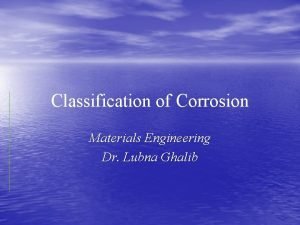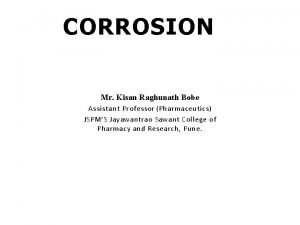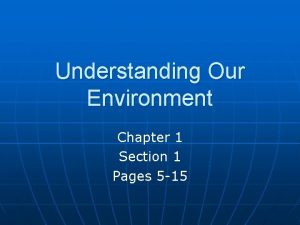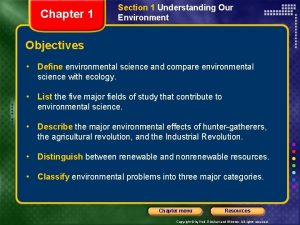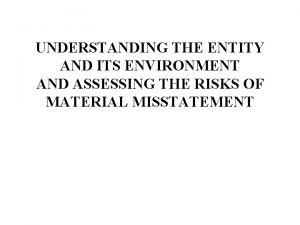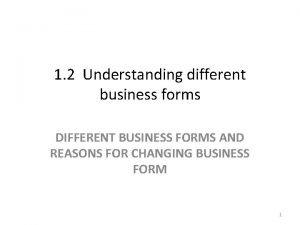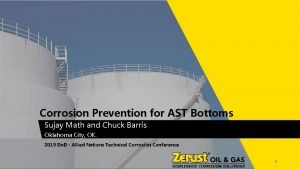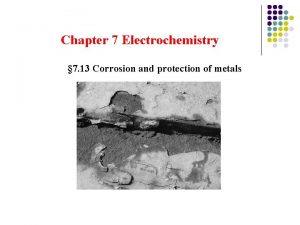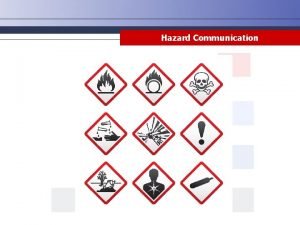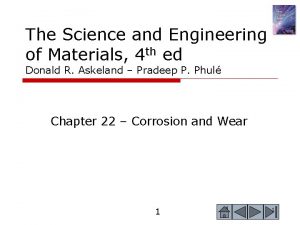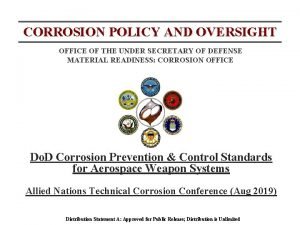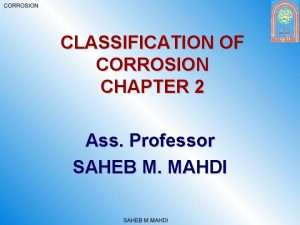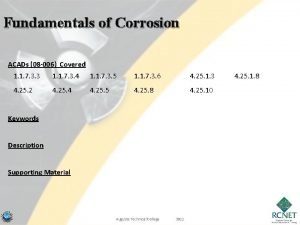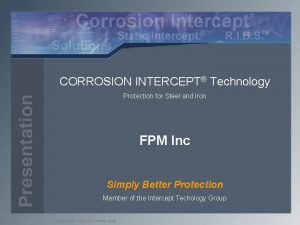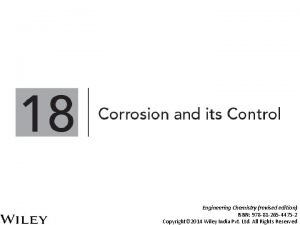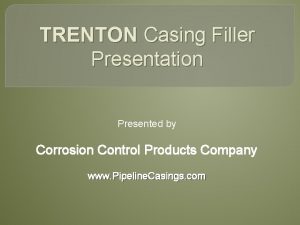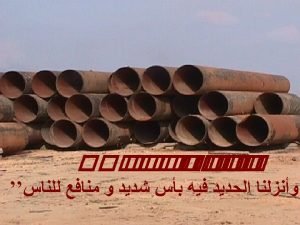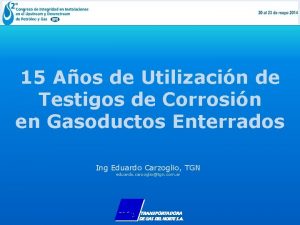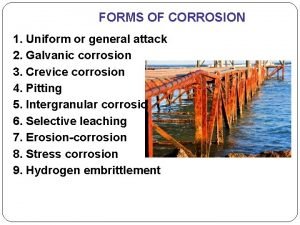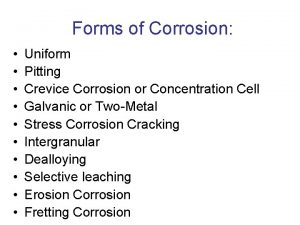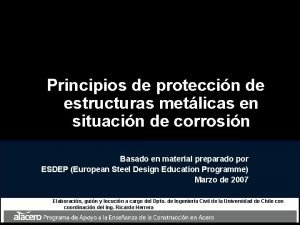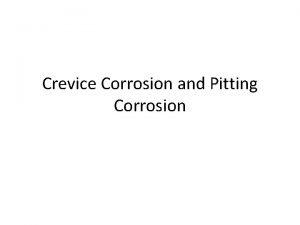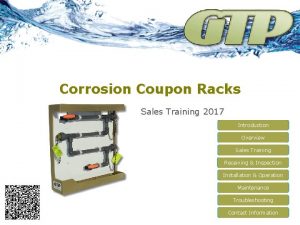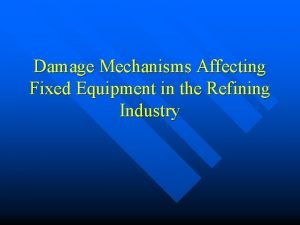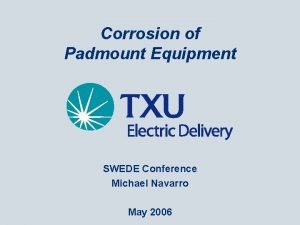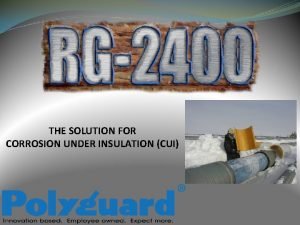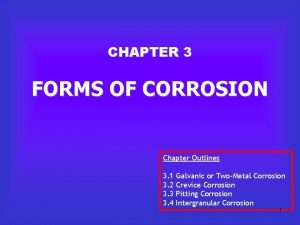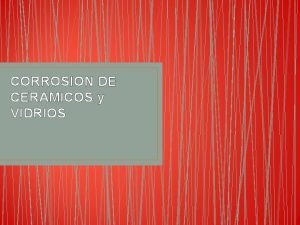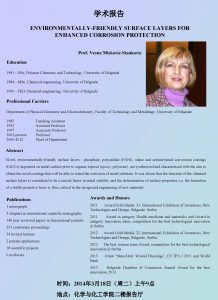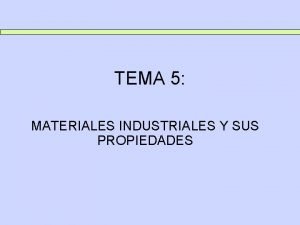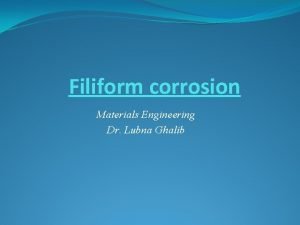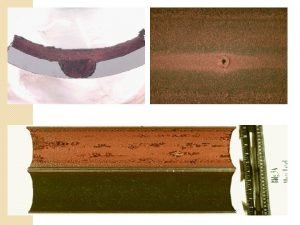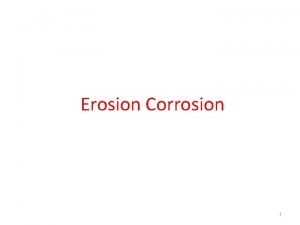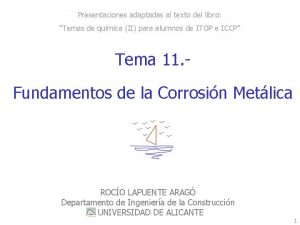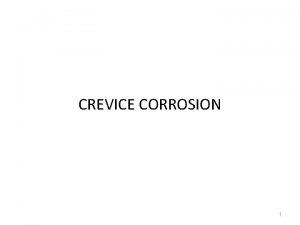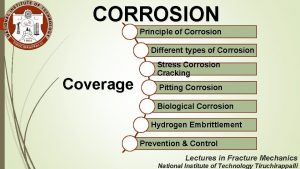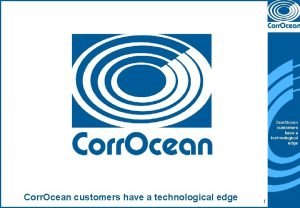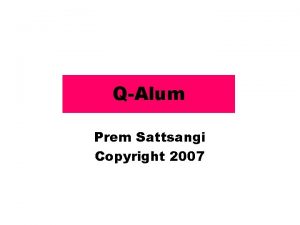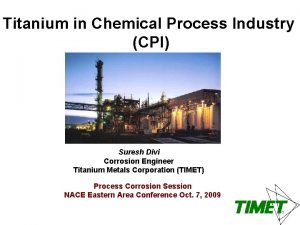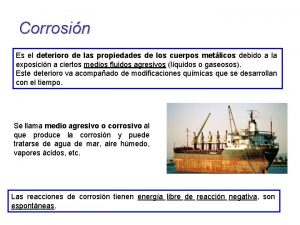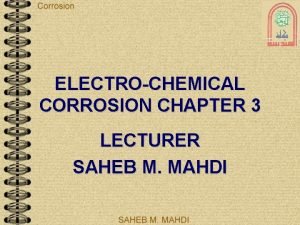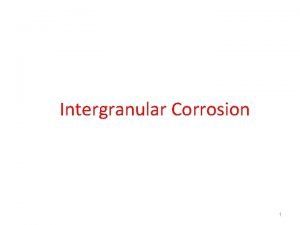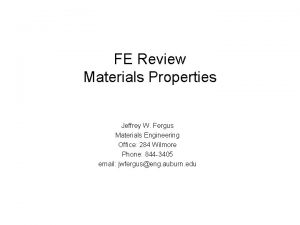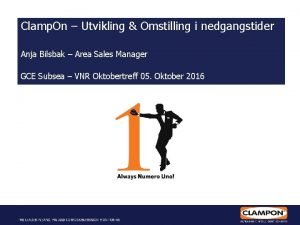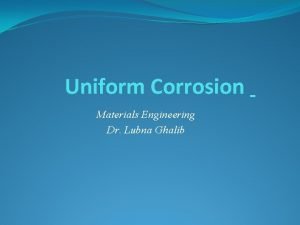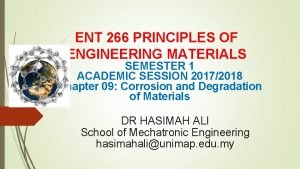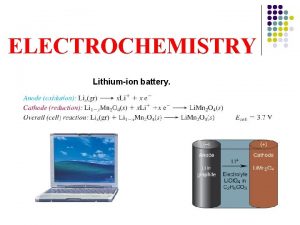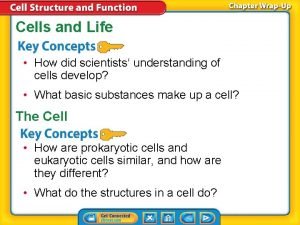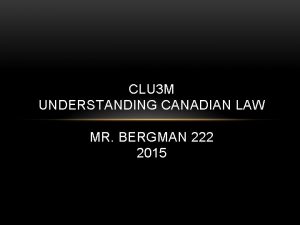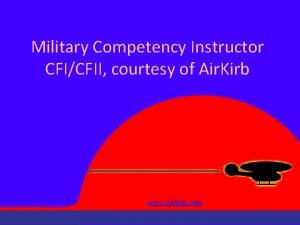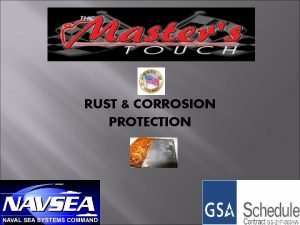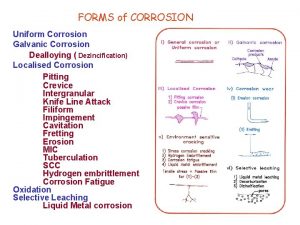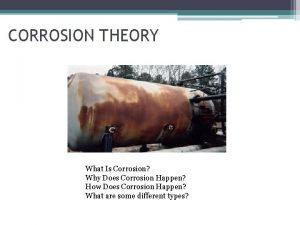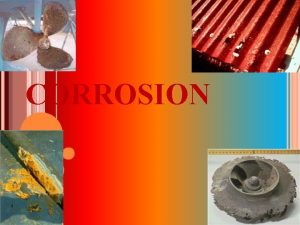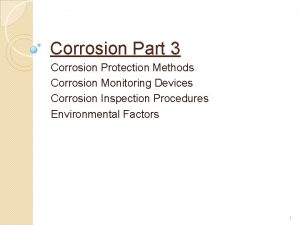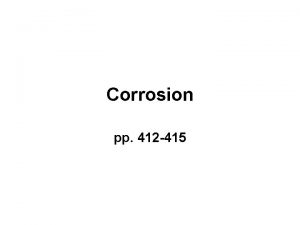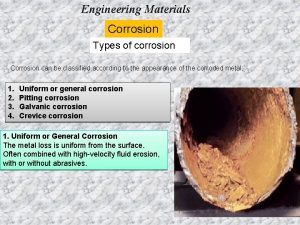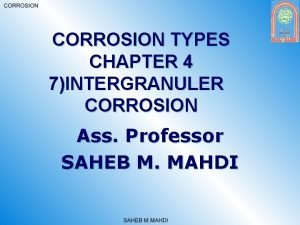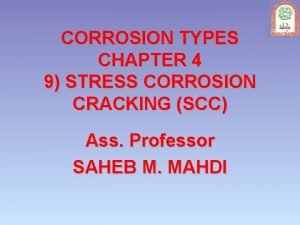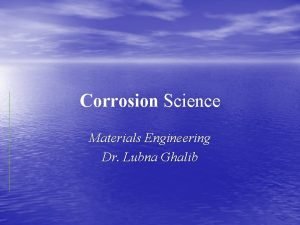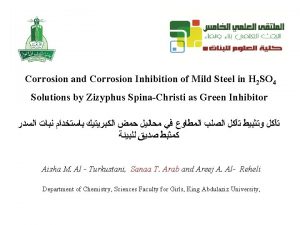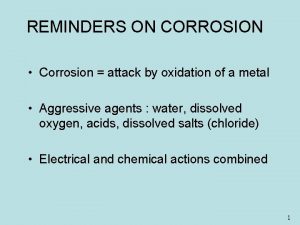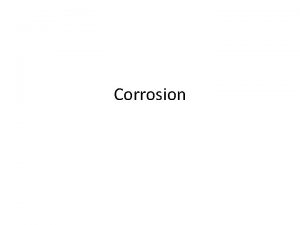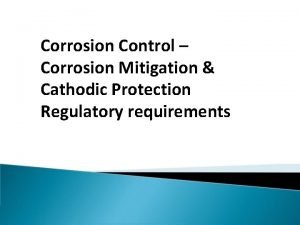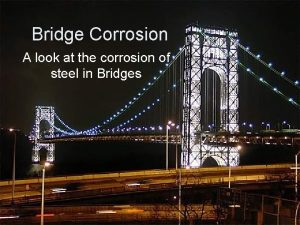The Corrosion Teachin Understanding the corrosion environment Different














































































































- Slides: 110

The Corrosion Teach-in Understanding the corrosion environment

Different methods for corrosion control Coupons Online Monitors Inhibition programs Any method be made more effective…

…When you understand the effect of the corrosion environment Corrosion rates vary with process conditions

5. 5% Na. Cl

5. 5% Na. Cl, 5 atm

5. 5% Na. Cl, 85 °C

5. 5% Na. Cl, 10 °C, 15 atm

To interpret coupon and monitor data… It helps to know the effect of variations in the field

To locate where to place sensors & coupons… Wait for a failure…? Rely on past experience?

Coupons Online Monitors Tell you what has already happened, not what will happen

OLI tools can help OLI gets the chemistry right

? Dew point Phase p. H splits

Understand what’s happening in your system Active Corrosion (dissolution) Protective Scale Passive Film p. H

Determine the rate limiting redox processes Passive region Activation controlled Rate-limiting cathodic process

Determine pitting potential and max growth rate No Pitting

Pro-active Analysis ØTest Corrective Actions • Determine optimum p. H • Screen alloys and inhibitors • Assess process changes ØFocus Lab work ØEliminate potential problems before they occur

The Corrosion Analyzer Tool for understanding the corrosion environment Ø Mechanistically based software tool ØSpeciation ØKinetics of uniform corrosion Partial anodic and cathodic processes ØTransport properties ØRepassivation

The Corrosion Analyzer Based on the OLI Engine Ø Complete speciation model for complex mixtures § Phase and chemical reaction equilibria § Accurate p. H prediction § Redox chemistry § Comprehensive coverage of industrial chemical and petroleum systems

The Corrosion Analyzer Based on the OLI Engine Ø Thermophysical properties prediction Ø Phenomenological and unique aqueous process models including kinetics and transport Ø “Out of the box” solution and technical support

The Corrosion Analyzer What It Does… Ø Predict metal dissolution regime, passive films, and surface deposits Ø Predict uniform corrosion rates and the potential for pitting corrosion Ø Generate real solution stability (Pourbaix) Diagrams Ø Produce theoretical polarization curves

The Corrosion Analyzer So you can gain insight on … Corrosion mechanisms Rate-limiting partial processes for your operating conditions Ø Effects of process and materials changes Ø Ø Therefore Ø Focusing lab time Ø Reducing risky plant/field testing Ø Managing design, operation, and maintenance

Today’s seminar “Hands-on” and “How-To” ØUsing example problems ØExamining plots and diagrams ØUnderstanding the basis of the predictions

Today’s Seminar Ø Ø Ø Perform “Single point” calculations Construct / interpret real solution Pourbaix Diagrams Calculate corrosion rates ØEvaluate the effects of p. H, T, comp / flow Ø Evaluate polarization curves ØGain insight to corrosion mechanisms ØSee rate limiting steps ØCan I read them? Can I trust them? Ø Determine the likelihood of pitting to occur For your actual field or lab conditions

Welcome to the CORROSION TEACH-IN Simulating Real World Corrosion Problems

Gas Condensate Corrosion Ø Scope l Gas condensates from alkanolamine gas sweetening plants can be highly corrosive. Ø Purpose l Diethanolamine is used to neutralize (sweeten) a natural gas stream. This removes carbon dioxide and hydrogen sulfide. The off gas from the regeneration is highly acidic and corrosive

Gas Condensate Corrosion Ø Objectives l l l Determine the dew point of the acid gas Remove the condensed phase and perform corrosion rate calculations Mitigate the corrosion

Sour Gas Absorber Gas Sweetening Acid Gas Absorber liquor regenerator

Acid Gas Concentrations Species Concentration (mole %) H 2 O 5. 42 CO 2 77. 4 N 2 0. 02 H 2 S 16. 6 Methane 0. 50 Ethane 0. 03 Propane 0. 03 Temperature 38 o. C Pressure 1. 2 Atm. Amount 100 moles

Application Time

Dew Point • Dew Point = 37. 6 o. C • p. H = 3. 93 • ORP = 0. 576 V

Corrosion Rates: Flow Conditions Ø Flow conditions have a direct effect on mass transfer l l l Static Pipe flow Rotating disk Rotating cylinder Complete agitation

Application Time

Carbon Steel Corrosion @ Dew Point Corrosion Rate = 0. 7 mm/yr H 2 CO 3(aq)= ½ H+ + HCO 3 - e - Corrosion Potential = -0. 43 V Repassivation Potential = > 2 V Current Density = 60. 5 A/cm 2 H 2 S(aq)= ½ H 2 + HS- - e HS-= ½ H 2 + S 2 - - e H+= ½ H 2 - e

Mitigation Ø Adjusting solution chemistry Ø Temperature profiling Ø Alloy screening Ø Cathodic protection

Adjusting the Solution Chemistry Ø Changing operating p. H l Add acid or base

Application Time

Adjusting solution p. H = 8. 0

Screening Alloys Ø Select an alloy that has a preferential corrosion rate l l 13% chromium 304 Stainless

Application Time

13 % Cr Steel Corrosion @ Dew Point Corrosion Rate = 0. 06 mm/yr Corrosion Potential = -0. 32 V Repassivation Potential = > 2 V Current Density = 5. 7 A/cm 2 H 2 CO 3(aq)= ½ H+ + HCO 3 - - e HS-= ½ H 2 + S 2 - - e

304 Stainless Steel Corrosion @ Dew Point Corrosion Rate = 0. 0036 mm/yr Corrosion Potential = -0. 15 V Repassivation Potential = > 2 V Current Density = 0. 3 A/cm 2

304 Stainless Steel Stability @ Dew Point Passivation is possible due to Cr 2 O 3

Why Iron Rusts Explaining common observations using Stability Diagrams

Basics Ø Iron is inherently unstable in water & oxidizes via the following reactions to form rust Ø Its severity depends on (among others) l l Ø Conditions (T/P), Composition, p. H, and oxidation potential These four can be plotted on a single chart called a stability diagram

Start example

Explaining the EH-p. H diagram using Fe, showing solid and dissolved species over range of p. H’s and oxidation potentials White area is region of iron corrosion Fe(III)3+ is the dominant ion Fe(II)2+ is the dominant ion H 2 O is s H 2 O is o xidized to O 2 and H + H 2 O is sta Fe( ble and a II) o erated xid Fe 2 O 3 Water Ox izes and red pre uce cipi s an tate d di s as sso Fe lves 2 O in w 3 ater table and deaerate d duced to H 2 and O H H 2 O is re Elemental iron (gray region) corrodes in water to form one of several phases, depending on p. H. At ~9 p. H and lower, water oxidizes Fe 0 to Fe+2 which dissolves in water (white region of the plot). As the oxidation potential increases (high dissolved O 2) Fe+2 precipitates as Fe. OOH, or rust (green region). The lower the p. H, the thicker the white region and the greater driving force for corrosion At higher p. H (10 11), Fe 0 forms Fe 3 O 4, a stable solid that precipitates on the iron surface, protecting it from further attack. idation Lin e Fe. O(OH), rust is stable in water at moderate to high p. H’s Water Re duction L Elemental iron, Fe(0) oxidizes to Fe(II) in the presence of water ine Fe 3 O 4 coats the iron surface, protecting it from corrosion Elemental iron, Fe(0) o, is stable and will not corrode in this region

Q: We all know O 2 is bad…But how much is bad? H 2 O is o xidized to H 2 O is sta O 2 and H + ble and a H 2 O is s table and H 2 O is re erated deaerate duced to d H 2 and O H Water Ox idation Lin e Pure water is here… No air, no acid, no base Water Re duction L ine 500 ppm O 2 0. 1 pp. T H 2 10 ppm O 2 0. 1 ppb H 2 3 ppb O 2 0. 1 ppm H 2 80 ppm H 2 0. 1 pp. T O 2

Iron and water react because they are not stable together The reaction generates 2 OH-, which increases the p. H Region of instability The reaction generates H 2, which puts the EH near the bottom line Elemental Iron (Feo)

Why is Stainless Steel stainless?

Cr will oxidizes, but the reaction goes through a tough Cr 2 O 3 protective layer.

Ni 3 Fe 2 O 4 is stable in the corrosion region, and will also protect the surface.

Welcome to the CORROSION TEACH-IN Simulating Real World Corrosion Problems

Corrosion in Seawater Ø Scope l l Metals used for handling sea water face both general and localized corrosion. Various grades of stainless steels have been used to mitigate the problems. Stainless steels owe their corrosion resistance to a thin adherent film of oxides on their surface. Disruption of the films can lead to localized corrosion and premature failure.

Corrosion in Seawater Ø Purpose l l Chlorine and oxygen in sea water can attack the films used to passivate the steels. The Corrosion. Analyzer will be used to model the effects of chloride and oxygen on the rates of uniform corrosion and the possibility of pitting on the surface of the metals.

Corrosion in Seawater Ø Objectives l l l Reconcile a sea water sample for electroneutrality Reconcile a gas analysis Calculate uniform rates of corrosion for • • • 304 stainless steel 316 stainless steel S 31254 stainless steel

Corrosion in Seawater Ø Objectives (continued) l Determine the probability of pitting using the localized corrosion feature.

Kinetic Model of General Corrosion: Mass Transfer Ø All reactions take place on the metal surface. Ø Films are a diffusion barrier to corrosive species Solution Metal Surface film l Ø Reduce mass transfer limited currents. Mass transfer from solution is calculated from a concentration dependent diffusion coefficient.

Chemistry Ø The rates of corrosion use a subset of the OLI Chemistry l Neutral Species • H 2 O, O 2, CO 2, H 2 S, N 2 and all inert gases, Cl 2, SO 2, So and NH 3, organic molecules that do not undergo electrochemical reactions l Anions • OH , Cl , Br , I , HCO 3 , CO 3 2, HS , S 2 , SO 42 , HSO 4 , SO 32 , NO 3 , Mo. O 42 , CN , Cl. O 4 , Cl. O 3 , Cl. O , acetate, formate, Cr(VI) anions, As(III) anions, P(V) anions, W(VI) anions, B(III) anions and Si(IV) anions.

Chemistry l Cations • H+, alkali metals, alkaline earth metals, Fe(II) cations, Fe(III) cations, Al(III) cations, Cd(II) cations, Sn(II) cations, Zn(II) cations, Cu(II) cations, Pb(II) cations and NH 4+.

Corrosion of 304 Stainless Steel in Deaerated Sea Water Species Concentrati on (mg/L) Cl 19000 Na+ 10700 Mg+2 1300 Ca+2 400 SO 4 2 2750 HCO 3 150 p. H 8. 0 Temperatu 25 o. C re Pressure 1 atm. Ø Lab. Analyzer used to reconcile electroneutrality Ø Na. OH/HCl Used to adjust p. H

Application Time

Screening Considerations Ø Some alloys do not perform well in seawater Ø We will evaluate 3 stainless steels l l Uniform corrosion rates Pitting possibility Ø Considering both deaerated and aerated conditions

Corrosion of 304 Stainless Steel in Deaerated Sea Water 300 years to lose 1 mm of metal. 0033 mm/yr @ 25 o. C

Corrosion of 304 Stainless Steel in Deaerated Sea Water Large difference means that pits are unlikely to form Repassivation Potential Corrosion Potential Difference = 0. 05 V Or if a pit forms, then it will passivate

Application Time

Corrosion of 316 SS in Deaerated Water. 00053 mm/yr @25 o. C 1886 years to lose 1 mm of metal Much better corrosion rate than 304 ss

Corrosion of 316 SS in Deaerated Water Difference = 0. 086 V

Application Time

Corrosion of 254 SMO in Deaerated Water Corrosion rate = 0. 00033 mm/yr @ 25 o. C > 3000 years to lose 1 mm of metal

Corrosion of 254 SMO in Deaerated Water Difference = 2. 7 V

Summary in Deaerated Water Stainless 304 Rate @ 25 Potential o. C (mm/yr) difference (V) 0. 0033 0. 05 316 0. 00053 0. 086 254 SMO 0. 00033 2. 7

Adding Air/Oxygen The Corrosion. Analyzer allows you to add a gas phase based only on partial pressures Ø You can set the water/gas ratio Ø Species Partial Pressure (atm) N 2 0. 7897 O 2 0. 21 CO 2 0. 0003 WGR 0. 01 bbl/scf

Application Time

304 SS in Aerated Solutions

304 SS in Aerated Solution The corrosion potential is greater than the passivation potential =. 37 V at max O 2 Pitting will occur

Application Time

316 SS Corrosion in Aerated Water Pitting occurs at higher oxygen concentrations =. 21 V at max O 2

Application Time

S 31254 Corrosion in Deaerated Water Pitting should not occur

Stability Diagram for 316 L SS

Stability Diagram for 316 L Nickel Only

Mitigation Ø Change Alloys l l Ø S 31254 seems the best at 25 o. C S 31254 increased potential for pitting at higher temperatures Cathodic Protection l l l Shifting of potential to less corrosive potentials via a sacrificial anode. Analyzers do not model CP Polarization curves can help determine the change in potential.

Welcome to the CORROSION TEACH-IN Simulating Real World Corrosion Problems

Dealloying of Copper Nickel Alloys Ø Scope l A copper nickel pipe made of Cupronickel 30 has been preferentially dealloyed while in contact with a 26 weight percent calcium chloride brine. It appears that the nickel in the alloy has been preferentially removed.

Dealloying of Copper Nickel Alloys Ø Purpose l The OLI/Corrosion. Analyzer will be used to show the relative stability of nickel and copper in the cupronickel alloy in an aqueous solution. It will show that protective films were not present as originally thought.

Dealloying of Copper Nickel Alloys Ø Objectives l l l Input information into the software and perform calculations Use stability diagrams to display information about the alloy and the protective films Change the diagrams to view different aspects of the stability of the alloy

Application: Dealloying of Copper Nickel Alloys A cupronickel 30 pipe (30 mass % copper) was used. Ø 26 wt % Ca. Cl 2 solution was in contact with the pipe. Ø Nickel was preferentially removed. Ø Dealloyed cupronickel pipe.

Questions? Ø Why did the nickel dealloy from the pipe? Ø What could we do to prevent this from occurring? Ø Which tools are available to understand this phenomenon?

Which Tools are Available? Ø A Pourbaix diagram can help us determine where metals are stable. l Corrosion. Analyzer

Creating the First Stability Diagram We will use the Corrosion. Analyzer to create a stability diagram for this system. Ø Features of Corrosion. Analyzer diagrams Ø l l Real solution activity coefficients Elevated temperatures Elevated pressures Interactions between species and overlay of diagrams.

The Pourbaix Diagram

Application Time to start working with the OLI Corrosion Analyzer

The Pourbaix Diagram Ø There are quite a few things to look at on this diagram. l l Ø Stability field for water Stability fields for nickel metal and copper metal Stability fields for nickel and copper oxides Stability fields for aqueous species. We will now break down the diagram in to more manageable parts.

Stability Diagram Features Ø Subsystems l A base species in its neutral state and all of its possible oxidation states. • Cuo, Cu+1, Cu+2 • Nio, Ni+2 l All solids and aqueous species that can be formed from the bulk chemistry for each oxidation state.

Stability Diagram Features Ø For each subsystem l Contact Surface • Base metals • Alloys l Films • Solids l l Solid Lines Aqueous Lines

Stability Diagram Features Ø Natural p. H l l Prediction based on the bulk fluid concentrations Displayed as a vertical line Ø Solids l l All solids included by default The chemistry can be modified to eliminate slow forming solids.

Stability Diagram Features Ø Passivity l l l Thin, oxidized protective films forming on metal or alloy surfaces. Transport barrier of corrosive species to metal surface. Blocks reaction sites

Water Stability Ø Water can act as an oxidizing agent l Water is reduced to hydrogen, H 2 Ø Water can act as a reducing agent l Water is oxidized to oxygen, O 2 Ø To be stable in aqueous solution, a species must not react with water through a redox process.

Copper Pourbaix Diagram Stable copper metal in alloy extending into water stability field. The solution p. H is in a region where the copper metal will be stable. Copper pipes are used for potable water for this reason.

Nickel Pourbaix Diagram No Nickel metal extends into the water stability field The solution p. H is in a region where nickel is expected to corrode

Ni Overlaid on Cu We need to know the Oxidation/Reduction potential Cu. Cl(s) may form to protect the alloy at the solution p. H. Since the nickel is part of a copper-nickel alloy, it is possible that copper could provide a protective film

Application Time

Corrosion. Analyzer Calculation

Corrosion. Analyzer Calculation The oxidation reduction potential is 0. 463 V

Ni Overlaid on Cu The potential of 0. 463 V lies above the passivating film. Dealloying can occur.

Conclusions Ø Why did dealloying occur? l l No protective film at the operating p. H and oxidation/reduction potential of the process fluid. Copper lies within the region of water stability Nickel does not lie within the region of water stability The presence of Cu+ ions in equilibrium with copper metal promotes replating of copper metal driven by the oxidation of nickel.

Chemistry Ø Standard OLI Chemistry l l l 7400 components 9100 individual species 82 Elements of the Periodic Table fully covered • 8 additional elements partially covered. Ø Stability diagrams have access all of this chemistry

Chemistry Ø Alloys l 6 predefined classes supported • • • l Cu Ni Carbon Steels – Fe, Mn, and C Ferritic Stainless steels – Fe, Cr, Ni, Mo and C Austenitic stainless steels Fe, Cr, Ni, Mo and C Duplex stainless steels FCC phase Fe, Cr, Ni, Mo, C and N User defined alloys

Limits to the Standard OLI Chemistry Aqueous Phase XH 2 O > 0. 65 50 o. C < T < 300 o. C 0 Atm < P < 1500 Atm 0 < I < 30 Non aqueous Liquid Currently no Activity Coefficient Model (i. e. , no NRTL, Unifaq/Uniqac) Fugacity Coefficients are determined from the Enhanced SRK

Limitations of Pourbaix Diagrams Ø No information on corrosion kinetics is provided. l Diagram is produced from only thermodynamics. Diagram is valid only for the calculated temperature and pressure Ø Oxide stability fields are calculated thermodynamically and may not provide an actual protective film. Ø Dealloying cannot be predicted from the diagram alone. Ø
 Dry and wet corrosion difference
Dry and wet corrosion difference Differentiate between dry corrosion and wet corrosion
Differentiate between dry corrosion and wet corrosion Chapter 1 section 1 understanding our environment answers
Chapter 1 section 1 understanding our environment answers Section 1 understanding our environment answer key
Section 1 understanding our environment answer key Ranjani saigal
Ranjani saigal Understanding the entity and its environment
Understanding the entity and its environment Understanding different business forms
Understanding different business forms Environment of business finance
Environment of business finance Examples of a medium in waves
Examples of a medium in waves Different people different things
Different people different things Why do different polymers have different properties
Why do different polymers have different properties Cultural relativism
Cultural relativism Argumenterande tal struktur
Argumenterande tal struktur Technicolor test
Technicolor test Different angle different story
Different angle different story Sound will travel at different speeds in different mediums.
Sound will travel at different speeds in different mediums. Different materials have different
Different materials have different Acids and bases song
Acids and bases song 2019 dod allied nations technical corrosion conference
2019 dod allied nations technical corrosion conference Waterline corrosion
Waterline corrosion Skin corrosion symbol
Skin corrosion symbol Chemical corrosion
Chemical corrosion Mil-std-889c
Mil-std-889c Classification of corrosion
Classification of corrosion What factors affect the rate of corrosion
What factors affect the rate of corrosion Corrosion intercept
Corrosion intercept Electrochemical theory of corrosion
Electrochemical theory of corrosion Seamsil cut edge corrosion treatment
Seamsil cut edge corrosion treatment Casing filler
Casing filler Celda de aireación diferencial
Celda de aireación diferencial Corrosion galvanique
Corrosion galvanique Testigo de corrosion
Testigo de corrosion Uniform attack corrosion
Uniform attack corrosion Erosion corrosion
Erosion corrosion Tipos de corrosion
Tipos de corrosion Pitting corrosion
Pitting corrosion Corrosion coupon rack installation
Corrosion coupon rack installation Sulfidation corrosion
Sulfidation corrosion Swede conference
Swede conference Corrosion under insulation primer
Corrosion under insulation primer Corrosion
Corrosion Corrosion del vidrio
Corrosion del vidrio Corrosion control solutions
Corrosion control solutions Corrosion propiedad fisica o quimica
Corrosion propiedad fisica o quimica What is filiform corrosion
What is filiform corrosion Stress corrosion
Stress corrosion Erosion corrosion can be controlled by
Erosion corrosion can be controlled by Libros de corrosion
Libros de corrosion Corrosion type
Corrosion type What is corrosion
What is corrosion Corrocean corrosion monitoring
Corrocean corrosion monitoring Aluminium corrosion equation
Aluminium corrosion equation Galvanic series chart
Galvanic series chart Zona anodica
Zona anodica Types of electrochemical corrosion
Types of electrochemical corrosion Corrosion intergranular
Corrosion intergranular Brittle failure
Brittle failure Clamp on subsea corrosion-erosion monitor
Clamp on subsea corrosion-erosion monitor Uniform corrosion mechanism
Uniform corrosion mechanism Prevention of corrosion
Prevention of corrosion Electrolytic cell notation
Electrolytic cell notation Vẽ hình chiếu vuông góc của vật thể sau
Vẽ hình chiếu vuông góc của vật thể sau Công thức tiính động năng
Công thức tiính động năng Thế nào là mạng điện lắp đặt kiểu nổi
Thế nào là mạng điện lắp đặt kiểu nổi Tỉ lệ cơ thể trẻ em
Tỉ lệ cơ thể trẻ em Lời thề hippocrates
Lời thề hippocrates Vẽ hình chiếu đứng bằng cạnh của vật thể
Vẽ hình chiếu đứng bằng cạnh của vật thể Quá trình desamine hóa có thể tạo ra
Quá trình desamine hóa có thể tạo ra Các môn thể thao bắt đầu bằng tiếng nhảy
Các môn thể thao bắt đầu bằng tiếng nhảy Hát kết hợp bộ gõ cơ thể
Hát kết hợp bộ gõ cơ thể Khi nào hổ con có thể sống độc lập
Khi nào hổ con có thể sống độc lập điện thế nghỉ
điện thế nghỉ Dot
Dot Thế nào là sự mỏi cơ
Thế nào là sự mỏi cơ Phản ứng thế ankan
Phản ứng thế ankan Trời xanh đây là của chúng ta thể thơ
Trời xanh đây là của chúng ta thể thơ Gấu đi như thế nào
Gấu đi như thế nào Thiếu nhi thế giới liên hoan
Thiếu nhi thế giới liên hoan Tia chieu sa te
Tia chieu sa te Một số thể thơ truyền thống
Một số thể thơ truyền thống Thế nào là hệ số cao nhất
Thế nào là hệ số cao nhất Lp html
Lp html Hệ hô hấp
Hệ hô hấp Thế nào là số nguyên tố
Thế nào là số nguyên tố đặc điểm cơ thể của người tối cổ
đặc điểm cơ thể của người tối cổ Mật thư anh em như thể tay chân
Mật thư anh em như thể tay chân Các châu lục và đại dương trên thế giới
Các châu lục và đại dương trên thế giới Tư thế worm breton là gì
Tư thế worm breton là gì ưu thế lai là gì
ưu thế lai là gì Thẻ vin
Thẻ vin Tư thế ngồi viết
Tư thế ngồi viết Cái miệng xinh xinh thế chỉ nói điều hay thôi
Cái miệng xinh xinh thế chỉ nói điều hay thôi Các châu lục và đại dương trên thế giới
Các châu lục và đại dương trên thế giới Từ ngữ thể hiện lòng nhân hậu
Từ ngữ thể hiện lòng nhân hậu Bổ thể
Bổ thể Tư thế ngồi viết
Tư thế ngồi viết Thế nào là giọng cùng tên? *
Thế nào là giọng cùng tên? * 101012 bằng
101012 bằng Thơ thất ngôn tứ tuyệt đường luật
Thơ thất ngôn tứ tuyệt đường luật Alleluia hat len nguoi oi
Alleluia hat len nguoi oi Hổ đẻ mỗi lứa mấy con
Hổ đẻ mỗi lứa mấy con đại từ thay thế
đại từ thay thế Diễn thế sinh thái là
Diễn thế sinh thái là How did scientists understanding of cells develop
How did scientists understanding of cells develop Understanding canadian law (clu3m)
Understanding canadian law (clu3m) Rote understanding application correlation
Rote understanding application correlation All learning is understanding relationships
All learning is understanding relationships Lesson 1-1 understanding points lines and planes
Lesson 1-1 understanding points lines and planes Advanced higher geography understanding standards
Advanced higher geography understanding standards Demonstrate knowledge and understanding
Demonstrate knowledge and understanding Understanding marketing management
Understanding marketing management
